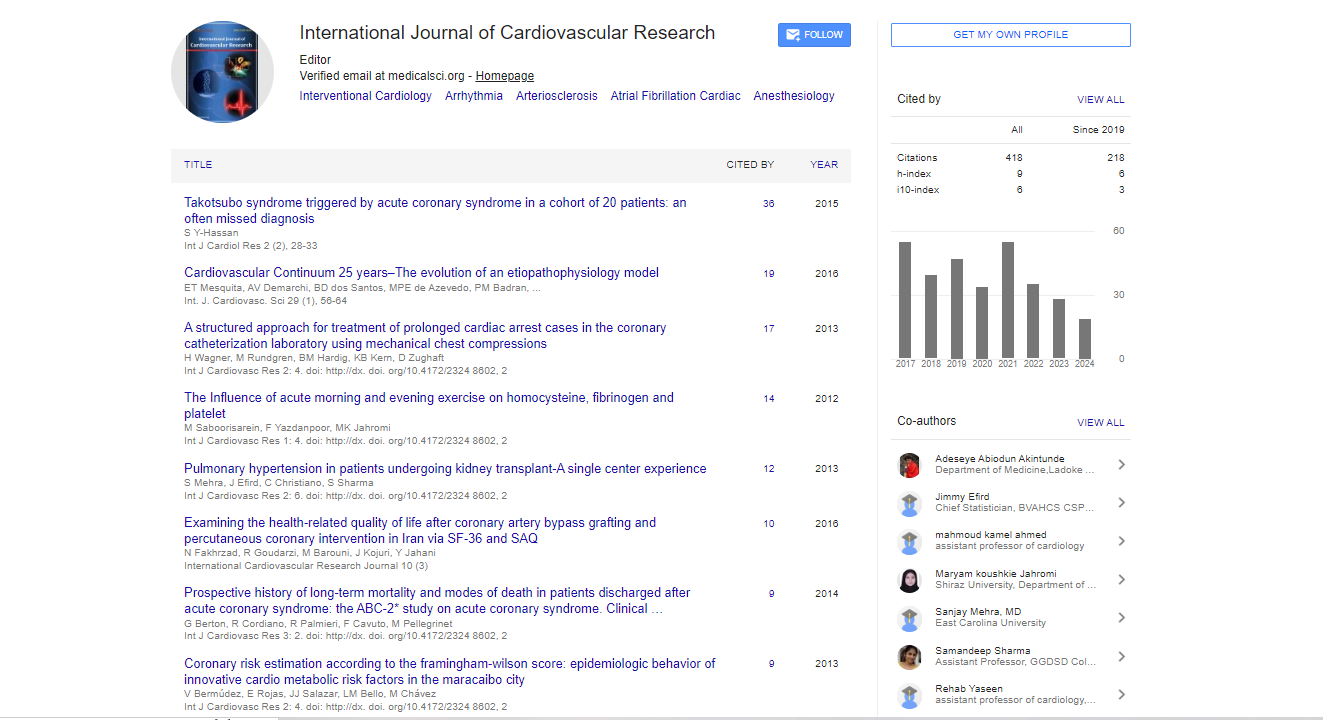Opinion Article, Int J Cardiol Res Vol: 13 Issue: 4
A Comprehensive Overview on Atrial Fibrillation and Stroke Prevention
Emily Johnson*
1Department of Cardiology, Stanford University School of Medicine, California, United States of America
*Corresponding Author: Emily Johnson,
Department of Cardiology, Stanford
University School of Medicine, California, United States of America
E-mail: emily.johnson@stanford.edu
Received date: 15 July, 2024 Manuscript No. ICRJ-24-149280;
Editor assigned date: 17 July, 2024, PreQC No. ICRJ-24-149280 (PQ);
Reviewed date: 31 July, 2024, QC No. ICRJ-24-149280;
Revised date: 07 August, 2024, Manuscript No. ICRJ-24-149280 (R);
Published date: 14 August, 2024, DOI: 10.4172/2324-8602.1000572
Citation: Johnson E (2024) A Comprehensive Overview on Atrial Fibrillation and Stroke Prevention. Int J Cardiol Res 13:4.
Description
Atrial Fibrillation (AF) is the most common cardiac arrhythmia, affecting millions of individuals worldwide. Characterized by an irregular and often rapid heart rate, AF results from disorganized electrical activity in the atria, leading to ineffective atrial contraction. This condition is clinically significant due to its association with severe complications, particularly ischemic stroke. AF increases the risk of stroke by 4 to 5 times compared to individuals without the arrhythmia, making stroke prevention an important aspect of AF management. Atrial fibrillation is a result of disrupted electrical signals within the atria, leading to chaotic atrial depolarizations. Normally, electrical impulses originate from the sinoatrial node and spread uniformly across the atria, causing a coordinated contraction. In AF, multiple ectopic foci and reentrant circuits form, leading to rapid and irregular atrial contractions. As a result, the atria quiver rather than effectively pump blood into the ventricles. This can lead to stasis of blood in the atria, particularly in the left atrial appendage, which in turn increases the likelihood of thrombus formation. These thrombi can dislodge and travel to the brain, causing ischemic strokes.
Given the increased risk of stroke in AF patients, effective stroke prevention is a cornerstone of AF management. There are two primary approaches to stroke prevention namely, anticoagulation therapy and rhythm control strategies. Anticoagulation therapy is the most effective strategy for reducing stroke risk in AF patients. Warfarin, the most commonly used Vitamin K Antagonists (VKA), has been the standard of care for stroke prevention in AF for decades. It works by inhibiting the synthesis of vitamin K-dependent clotting factors, thus reducing thrombus formation. While effective, warfarin requires regular monitoring of the International Normalized Ratio (INR) and has numerous dietary and drug interactions, making it challenging to manage. In recent years, Direct Oral Anticoagulants (DOACs) such as dabigatran, rivaroxaban, apixaban and edoxaban have emerged as alternatives to warfarin. Clinical trials have demonstrated that DOACs are at least as effective as warfarin in preventing stroke in AF patients, with a reduced risk of major bleeding, particularly intracranial hemorrhage. Although less effective than anticoagulation, antiplatelet agents such as aspirin may be used in patients who are unable to tolerate anticoagulants. However, due to their lower efficacy in reducing stroke risk, current guidelines generally recommend anticoagulation over antiplatelet therapy for most AF patients.
For patients who are at high risk for bleeding and cannot tolerate long term anticoagulation, Left Atrial Appendage Occlusion (LAAO) provides an alternative strategy for stroke prevention. The left atrial appendage is the primary site of thrombus formation in AF patients and occlusion of this structure using devices such as the watchman device can reduce the risk of stroke. While LAAO is an invasive procedure, it has shown promise in clinical trials and is increasingly used in patients who are not candidates for anticoagulation. While the primary focus in AF management is stroke prevention, controlling the heart rate and rhythm can also reduce the risk of stroke by restoring more effective atrial contraction and reducing atrial stasis. Rate control involves the use of medications such as beta blockers or calcium channel blockers to slow the ventricular rate, improving hemodynamics. Rhythm control, on the other hand, aims to restore and maintain normal sinus rhythm using antiarrhythmic drugs or electrical cardioversion. Catheter ablation is another rhythm control strategy that involves isolating or destroying the ectopic foci responsible for AF. While effective in select patients, catheter ablation is generally reserved for symptomatic patients or those with persistent AF who have not responded to other treatments. Anticoagulation therapy requires long-term adherence and many patients struggle to take their medications consistently, particularly those on VKAs like warfarin due to the need for frequent monitoring. Anticoagulants carry an inherent risk of bleeding and the balance between preventing stroke and avoiding hemorrhage can be difficult to achieve, especially in elderly patients or those with a history of gastrointestinal or intracranial bleeding. The diverse range of comorbidities seen in AF patients complicates treatment, as certain therapies may not be suitable for all individuals. Personalized medicine approaches, including genetic testing for anticoagulation sensitivity, may help to optimize treatment in the future.
Conclusion
Atrial fibrillation is a major risk factor for stroke and the management of AF is fundamentally centered on stroke prevention. Advances in anticoagulation therapy, particularly with the development of DOACs, have revolutionized the prevention of stroke in AF patients, providing safer and more convenient options than traditional VKAs. However, challenges remain, particularly regarding the bleeding risks associated with anticoagulation and the need for individualized patient management. Future study and clinical advances, including personalized medicine and novel devices, are likely to further improve stroke prevention in AF, reducing the burden of this arrhythmia on patients and healthcare systems alike.
 Spanish
Spanish  Chinese
Chinese  Russian
Russian  German
German  French
French  Japanese
Japanese  Portuguese
Portuguese  Hindi
Hindi 



